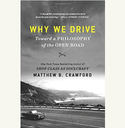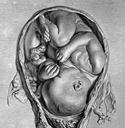Rita Arditi,
Test-Tube Women: What Future for Motherhood?
(Boston, MA: Pandora Press, 1984).
Gena Corea,
The Mother Machine: Reproductive Technologies from Artificial Insemination to Artificial Wombs
(New York, NY: Harper& Row, 1985).
Debra Evans,
Without Moral Limits: Women, Reproduction and Medical Technology
(Wheaton IL: Crossway Books, 2000).
Patricia & Steinberg Spallone,
Made to Order: The Myth of Reproductive and Genetic Progress
(New York, NY: Pergamon Press, 1987).
Early in her book, Without Moral Limits, Debra Evans quotes Leon Kass on the real situation in providing a child by ART, while the woman herself remains infertile. "What is being ‘treated' is her desire - a perfectly normal and unobjectionable desire - to bear a child." Instead of moderation and education of this desire - another name for virtue - the desire is indulged "beyond moral limits" to the detriment of the embryo/child and the womb/woman and society. In solving a mystery, the traditional motto is "cherchez la femme." In unraveling the tangle of who wants what in ART, the motto might be "search out the source of desire." Whose often quite legitimate desires are being satisfied and/or exploited, even self-exploited?
This can be a particularly useful method in looking at the various players in the ART arena, the scientists and physicians, male or female, who experiment and perform the operations, the men and/or women who seek the procedures, the victims who willingly or unwillingly are affected. In examining these books on women and ART, several desires were uncovered beyond the simple desire of a woman to have a child. Feminists, for example, want control of their reproductive processes through contraception and abortion but fear losing control to the medical profession in ART Medical researchers are often motivated by an overweening desire for knowledge and control of reproductive processes, while masking it under the guise of helping the infertile woman/couple. This essay will consider the response of women to ART as presented in these four books through the lens of desire both ordinate and inordinate. Legitimate desires call for legitimate means to fulfill them. Central will be the question of whether the technology of ART is in itself destructive of human, especially woman's nature, or is it the use of technology in the grip of uncontrolled desire?
Michael Hanby elsewhere on this site has already outlined the destructive nature of ART for the child and the state of childhood or filiality, which is the foundation of personhood and constitutes the core of what it means to be a human being. This essay will not repeat that but rather turn to its effect on woman from alternately the radical feminist and Christian perspectives of these authors. Both are only too aware of the dangers to women. Feminist Gena Corea, who wrote one of the first books criticizing ART in 1979, at the close of an article for Test-Tube Women on "Egg Snatchers," confesses, "Sitting at my typewriter night after night, I see my writing on the new reproductive technologies as a scream of warning to other women" (p. 48). As Debra Evans learned more about ART and of its so-called "final liberation of women" from their "biological destiny," she "often wept at the vision that emerged" (Evans, p. 14).
Desire for a Child
Let us first look at the desire for a child. Evans tells the story of a couple, John and Doris Del Zio, who were the first to attempt in vitro fertilization (IVF) in the United States. She quotes Doris as saying: "I didn't do it to be first; I did it because I desperately wanted to have a baby." Evans then tells of the succession of difficult operations she endured before being offered the experimental procedure of IVF, which involved painful harvesting of her eggs, fertilization in a petri dish and implantation in her womb. Doris failed to get pregnant, but she represents thousands of women who will go to extreme lengths to have a child. Such a desire overrides all consideration of what the woman is doing to herself, to her marriage, to the child, both the one/s conceived, the ones "selectively terminated" or frozen for future use, not to mention the effect on family and society, when a sperm or egg donor or a surrogate mother are part of the picture.
It is not always the woman who desires the child. In a study in a Sydney hospital reported by Christine Crowe in Made to Order, the women experienced social disapproval and isolation from other mothers as a consequence of infertility leading to guilt. Yet even if the woman would accept adoption, the husband often preferred a biological child or none. Taking on both her own and her husband's infertility problem, the woman feels compelled to participate in ART, which makes acceptance of infertility difficult. Radical feminists approach the problem by claiming that women are programmed to desire motherhood and society itself must be changed to support gender-neutral parenting.
The desire to have the perfect child is also fed by these technologies, since sperm and egg donors can be chosen for desired traits and the embryo/fetus tested for abnormalities and aborted. Some 90 percent of children diagnosed prenatally with Down's syndrome and Spina Bifida are aborted. Further, the question is asked by feminists, "whose desire for a child?" They point out that while women in the industrialized West and the wealthy elites in developing countries have access to the latest ART, the emphasis in third-world countries such as China and India is on the limitation of births, even by harsh means. Third world countries instead become a source of surrogate mothers (The Mother Machine, 215)
The Desire for Autonomy, Choice, Control
In Test-Tube Women Barbara Katz Rothman states the feminist case for choice, since choice and information have served as the cornerstones of the women's rights. "We are above all pro-choice," and without doubt, "contraception and abortion are the sine qua non of the reproductive rights movement" (pp. 23, 26). Rothman asks if some choices do not close down others. For example, while women must be free to control fertility, what of the choice not to control it? Women are losing the right not to abort and to have large families. Through prenatal screening women are also losing the right not to know and to accept the less than perfect baby, the Down's syndrome child for example. Information by itself, she says, does not guarantee whose choices will be met. She is troubled by the abortion of fetuses of the "wrong sex," overwhelmingly female. Rothman makes clear the contradictions of the feminist movement with regard to freedom and choice. She puts it starkly. "All [reproductive] techniques empower and all enslave women." Her solution is a politics of social control, hardly a prescription for freedom of choice, as the latest DHHS mandate on contraceptive coverage, which violates the freedom of religion clause of the US constitution, shows.
Unable to accept the contradictions, feminists lay the blame on patriarchy. Gena Corea points to the unwillingness of men to interfere with their own fertility in order to achieve this "brave new world." In 1974, 20 years after the first baby was conceived with frozen sperm, the procedure was still called experimental, while a mere four years after the first test tube baby was born, IVF was no longer considered experimental (Corea, pp. 34, 35). Referring to "the subversive sperm," she claims that artificial insemination with donor sperm (AID) is alarming men, since a wife could now get pregnant with another man's sperm. In a study on AID it was found that because husbands equate AID with infidelity and adultery, it led to family problems. Since 1976 both single heterosexual and lesbian women have availed themselves of AID, and inseminated themselves. This may be enough in itself to give a responsible pause to AID.
Corea sees patriarchy primarily at work. She charges that compared with women's continuous and men's discontinuous reproductive experience, men sense a lack of connection to the next generation, which they overcome by controlling the process itself. Later on Corea accuses "the patriarchal mentality," which views nature (and nature includes women) as a force to be controlled and mastered, of creating pesticides, contraceptives and herbicides that lead women to need ART, ignoring the fact that feminists consider access to contraception a fundamental woman's right
The Desire for Power over Nature
Women are particularly conscious of the power of technology to transform nature. They see clearly the "logic of the machine" which objectivizes the woman's body so that it is treated like a thing that can be bought and sold. Rowland in Made to Order complains that women's "bodies are used as living laboratories (p. 74). Gena Corea (author of The Mother Machine) in Test Tube Women refers to "dismembered motherhood," charging that women are treated like animals (p. 47). Indeed along with Corea, Debra Evans in Without Moral Limits shows how animal breeding methods were transferred wholesale to women in ART Julie Murphy in Test-Tube Women describes women's bodies as "fertile fields to be farmed. Women are regarded as commodities with vital products to harvest, eggs" (p. 68). On the question of surrogacy, she asks: "Is the surrogate mother a prostitute or is she instead a modern extension of the wet nurse? Is it baby selling or organ selling?
A particularly insightful and passionate article in Made to Order is contributed by Maria Mies. "Why don't you simply say... that this new technological development frightens you, that you don't need it, that it is inhuman and inimical to women and you won't buy it? (p. 35). Mies recognizes technical progress is not neutral but always based on the domination of nature. She sees the goal of the enterprise "to become independent of the hazards, the ‘moods' of nature - and of the women out of whom life comes." To use technology well, she goes on, we must begin with "our relationship to nature, to other people, and we would first have to determine what the ‘good life,' happiness without exploitation is." All routine work, which technology seeks to relieve, isper se burdensome and monotonous. But she sees a great difference between mindless factory work and the routine work of a woman looking after her children. "It is never only a burden but always a pleasure too." Mies is under no illusion that women can equally misuse the power of technology, citing lesbians, who support the idea of cloning to eliminate men. Mies also charges women with being complicit with the system, "glad that the system seems so ‘powerful' and - apparently - gives them no chance [of change]."
Desire for the Good Life
Both Debra Evans and Maria Mies argue that the good life cannot be achieved simply by technology. Technical progress, Mies says is supposed to create the "good life," but since what it produces are always "dead" products no "good life" results. She charges that the machine destroys creativity, epitomized by addiction to computers with a consequent loss of spontaneous human communication, and loss of thinking and feeling even of our bodies. Her prescription is to opt out of the consumer society in favor of "the restoration of our capacity for subsistence production." In other words, our desire for ever-greater mastery over nature needs to be circumscribed by limits. Evans, coming from a Christian perspective, is more specific about the kind of limits needed. She refers to them as moral limits, which ensure the dignity of the human person and the fundamental relationships of the family. In discussing the limits that are being crossed she cites Dr Teresia Iglesias:
"It is clear that there are two fundamental and related assumptions underlying the current ethical guidelines and practice of IVF [and all ART]: The first assumption is that the early human embryo does not enjoy full human status; the second is that the values and interests of science override the value and interests of the newly conceived human being."
In an appendix, Evans gives the text of the Vatican Instruction on Respect for Human Life and the Dignity of Procreation, which was summed up in section no. 7: any medical intervention in human procreation "must be evaluated not only with reference to its technical dimension, but also and above all in relation to its goal, which is the good of persons and their bodily and psychological health... the dignity of human persons, of their sexuality and of their origin."
Feminists, as we have seen, have opposed in one way or another all forms of ART, but by endorsing contraception and abortion in the name of freedom and choice they have mowed down all moral limits to reproductive technology on the part of the medical profession and scientific research. Limits inevitably involve frustration of desire, and this is what our culture refuses to countenance. Limits to desire are met with more technology to mitigate the effects of uncontrolled desire, especially in the area of sexuality. When promiscuous sex leads to disease, or contraception leads to infertility, the recourse is to more technology, not to the recognition of limits. Perhaps here one can transpose a word from Wendell Berry, in his 2012 Jefferson Lecture sponsored by the National Endowment for the Humanities, deploring the disappearance of the small family farm in favor of the industrial plantation.
"The problem that ought to concern us first is the fairly recent dismantling of our old understanding and acceptance of human limits. For a long time we knew that we were not, and could never be, ‘as gods.' We knew, or retained the capacity to learn that our intelligence could get us into trouble that it could not get us out of."
The Acceptance of Limits and the Education of Desire
Is there an alternative? In a second appendix Evans describes and testifies to "A Christ-Centered Approach to Infertility." "When it comes to bearing a child, in whom," she asks, "will we place our highest trust - in God or modern medicine?" She speaks from the perspective of a mother whose daughter gave birth to a baby diagnosed with Hydrocephalus and Spina Bifida. She speaks of both the pain and the joy of accepting such a child, who is one of the few to survive prenatal screening. Neither Evans nor the feminist authors of these books on ART make reference to a technology that respects limits and, at the same time, treats the causes of infertility, what is called Naprotechnology, pioneered by Dr Thomas W. Hilgers at the Paul VI Institute, Omaha, NE. Based on monitoring the fertility signs of the body, this arose out of the modern scientific methods of natural family planning (NFP), which give couples a joint method of spacing births. NFP, too little known and practiced, both calls for and teaches the education of desire and its joyful fruition on all levels, physical, emotional, and spiritual.



